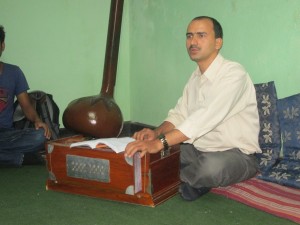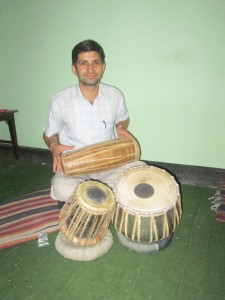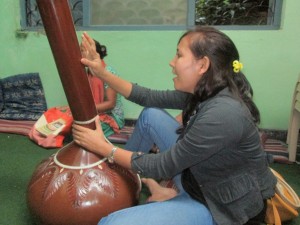In a country of many cultures and peoples it is not surprising to find that some parts of the country have traditional musical instruments distinct to their particular musical cultural heritages. In addition, there are a number of musical instruments that are mainly the same — but with some particular features — as those found in the Republic of India, yet which have distinct features (rather like Chinese and Japanese pagoda architecture sharing the same core dynamics and principles, yet each being distinct in its own right). Again, it is important to be aware that much of the northern part of the Indian sub-continent formed the cradle of an ancient civilisation that in fact spanned modern day Nepal and neighbouring states of the Republic of India.

Professor Shiva Raj Poudel, Lead for the Music Faculty of Lalit Kala Arts Campus (Tribhuvan University), Kathmandu. Professor Shiva is one of the Lalit Kala Campus group of internationally renowned artists and musicians supporting the educational work of the NIAP
Again other musical instruments long used in Nepal, and contributing to its musical heritage, have origins from the broader world, and yet have been utilised in making music that is distinct to Nepal.
About Classical Nepali Musical Instruments:
The NIAP’s technical advisor for Classical Nepali Music, Sita Maiya Rajchal, has provided an overview (provided below) of the most important instruments used in classical Nepali music compositions: these highlight that Nepali classical music and the classical music known to the south in the Republic of India share in most, but not all cases a shared common basis. However, as will be seen in some cases there are distinct Nepali classical musical instruments, in addition to the shared heritage derived in many cases from the earliest times.
Also included below under the Nepali Sarangi entry is an article about the background to this important uniquely Nepali musical instument, by Srijana Thapa (UKNFS Womens Section lead 2013 – 2014, and Principle NIAP Nepali Community support officer with the Bournemouth & Poole College NIAP supportive programme (Jan – February 2015) …. Story behind the Saarangi.
Sitar:
The sitar English pronunciation: /ˈsɪtɑr/ is a plucked stringed instrument used mainly in Hindustani music and Indian classical music. The instrument descended from a similar but simpler Persian instrument called the Setar (meaning “three strings”) and its predecessor the Dutar (meaning “two strings”). The sitar flourished in the 16th and 17th centuries and arrived at its present form in 18th century India. It derives its distinctive timbre and resonance from sympathetic strings, bridge design, a long hollow neck and a gourd resonating chamber.
Used widely throughout the Indian subcontinent, the sitar became popularly known in the wider world through the work of Ravi Shankar beginning in the late 1950s and early 1960s.[1] The sitar saw further use in popular music after the Beatles featured the sitar in their compositions “Norwegian Wood (This Bird Has Flown)”, “Within You Without You”, “Tomorrow Never Knows” and “Love You To”. Their use of the instrument came as a result of George Harrison’s taking lessons on how to play it from Shankar and Shambhu Das.[2] Brian Jones of the Rolling Stones also used a sitar in “Paint It Black” and a brief fad began for using the instrument in pop songs.
Flute (Bansuri):
The bansuri (Hindi: बांसुरी, Urdu: بانسری, Nepali: बाँसुरी, Marathi: बासरी, Assamese: বাঁহী, Bengali: বাঁশি) is a transverse flute of India made from a single hollow shaft of bamboo with six or seven finger holes. An ancient musical instrument associated with cowherds and the pastoral tradition, it is intimately linked to the love story of Krishna and Radha and is also depicted in Buddhist paintings from around 100 CE. The Bansuri is revered as Lord Krishna’s divine instrument and is often associated with Krishna’s Rasa lila; mythological accounts tell of the tunes of Krishna’s flute having a spellbinding and enthralling effect not only on the women of the Braj, but even on the animals of the region. The North Indian bansuri, typically about 14 inches in length, was traditionally used as a soprano instrument primarily for accompaniment in lighter compositions including film music. The bass variety (approximately 30″, tonic E3 at A440Hz), pioneered by Pannalal Ghosh has now been indispensable in Hindustani Classical music for well over half a century. Bansuris range in size from less than 12″ to nearly 40″.
Madal:
The Madal (Nepali: मादल), used mainly for rhythm-keeping in Nepalese folk music, is the most popular and widely used hand drum in Nepal. The Madal consists of a cylindrical body with a slight bulge at its center, closed on both ends. (The sides are often referred to as “heads”; one head is smaller than the other). The madal has a strand that goes around the waist of the person playing it to hold it horizontally. Playing technique involves rhythmic striking of either of the ends (heads) with the palm of the hand. The heads vibrate to produce sound when struck.
This typical Nepalese percussion instrument is the backbone of most of Nepali folk music. The well-known Nepali musician Ranjit Gazmer introduced this instrument to Bollywood music, when he started working under Rahul Dev Burman, and has used it in numerous Bollywood songs such as ‘Hum dono do premi duniya chhod chale’, ‘Kanchhi re kanchhi re’ and many others. There is also a madal drum among certain Adivasi groups.
The Madal originated in the Magar community of Nepal.[1] However, everybody all over Nepal use it. For example, it has been said that the Madal was played at Buddha’s wedding.
Nepalese Madal:
The Madal is a rhythm-keeping drum for folk songs in Nepal. It averages two feet in length and six inches in diameter. Black dots made of iron filings, flour and egg are burned onto the skins in the center giving the skin weight that causes the tone to reverberate like a low pitched bell. They are usually accompanied by a hollow head instrument that goes by the name Sarangi (which is different from the Indian Sarangi that has a hollow leather-covered head upon which the string bridge rests).
A large version of the Madal is called a Pachima or Khin (the former having round tuning pegs) and can be up to three feet in length and one foot in diameter. Like the madal, it has a syahi dot on each skin which makes the strikes continue to resonate. This drum is most similar to the Indian pakhawaj drum except for its rounded shape.
The Nepalese “shaman drum” is called Dhyangro (pictured left) which is beat with a coiled stick. This drum typically has a two foot head with a triangular carved pointed stick coming out of the bottom. It bears a striking resemblance to the Tibetan Na drum which is used in sutra chanting. (pictured right)
The Nepali frame drum is referred to as the Damfu and can be distinquished from other frame drums by the pegs holding the skin which stick out perpendicularly from the frame.
A copper barrel drum called a Temay is similar in size but lacks the the black shiyahi dots. It is played in processions with a stick.
Tabala:
The tabla (or tabl, tabla) (Hindi: तबला, Bengali: তবলা, Urdu: طبلہ, Arabic: طبل، طبلة, Persian: طبل) is a membranophone percussion instrument (similar to their Afro-Cuban/Latin-American drum-based relatives bongos), which is often used in Hindustani classical music. It is still used in the music behind folk and sufi poetry. It later became a part of Hindustani music industry. The instrument consists of a pair of hand drums of contrasting sizes and timbres. The term tabla is derived from an Arabic word, tabl, which simply means “drum.”[1] The tabla is used in some other Asian musical traditions outside of India, such as in the Indonesian dangdut genre.[2]
Playing technique involves extensive use of the fingers and palms in various configurations to create a wide variety of different sounds, reflected in the mnemonic syllables (bol). The heel of the hand is used to apply pressure or in a sliding motion on the larger drum so that the pitch is changed during the sound’s decay.
Nepali Drum:
Madal (Nepalese Drum, Nepali: मादल) is traditional musical instrument of Nepal. Madal is the most important instrument in Nepalese folk songs. It contains hollow and cylindrical wooden body called Ghar (Nepali:घार ). The opening of the wooden cylinder is covered by starched leather (leather strings are woven in such a way that, the skin on the two ends get stretched ). The leather is made up of goat or ox skin. The stretched leather produces sound when beaten, and the inner hollow part helps to give reverberation to the beat. Right side is smaller and the left is bigger, hence left side gives bass sound. Fingers and palms of both hands are used to bit the drum to produce sound.
The woven leather strings stretches the skins of the two ends; the strings are called Taan (Nepali: तान). Taan contains metal rings to tune it Some part of the streched circular skin is covered by black material called Khari (Nepali: खरी). Khari used to make traditionally by applying a paste of straw ashes and cooked rice. The uncolored region between Khari and outer circumference is called Maidan (Nepali: मैदान). The leather string used to hang Madal is called Juina (Nepali: जुईना)
Sarangi:
The sārangī (Hindi: सारंगी, Urdu: سارنگی) is a bowed, short-necked string instrument from South Asia which is used in Hindustani classical music. It is said to most resemble the sound of the human voice – able to imitate vocal ornaments such as gamaks (shakes) and meends (sliding movements).
There are different versions for the meaning and origins of “sarangi” The word “sarangi” could be a combination of two sanskrit words: “saar” (summary) and “ang” (form, herein different styles of playing instrumental music for e.g. “gayaki ang”) hence meaning the instrument that can summarize every style of music or playing.”Sarang” in fact has a number of meanings in Sanskrit.
According to some musicians, the word sarangi is a combination of two words ‘seh’(Persian equivalent of three) and ‘rangi’ (Persian equivalent of colored) corrupted as sarangi. The term seh-rangi represents the three melody strings.However the most common folk etymology is that sarangi is derived from ‘sol rang'(a hundred colours) indicating its adaptability to many styles of vocal music, its flexible tunability, and its ability to produce a large palette of tonal colour and emotional nuance.
According to some, the sarangi now enjoys the status of a solo classical instrument due to the efforts of Ram Narayan. Ram Narayan uses a variation to the fingering technique which differs from the standard Delhi fingering in that the note Ga (the third degree of the scale) is played with the middle finger rather than the first finger. However Ustad Bundu Khan (the nephew of Mamman Khan(, widely said to be the greatest sarangi player of all time, was well known as a soloist. And sarangi players, although normally employed as accompanists to vocal music and dance, have always played and taught a solo performance style based on vocal music.
Nepali Sarangi:
The sarangi (Nepali: सारङ्गी) is a folk Nepalese string instrument. Unlike the classical Indian sarangi which has many sympathetic strings which are not bowed, the Nepali has only four strings, all of which are played. Traditionally in Nepal, sarangi was only played by people of Gandarva or Gaine caste, who sing narrative tales and folk song.[1] However, in present days, its widely used and played by many. The sarangi has largely usurped the role of the previous Gaine instrument, the plucked lute arbajo.
Traditional Nepali sarangi is made up of single piece of wood having a neck and hollowed-out double-chambered body; it is often made from a very light wood called khiro. The lower opening is then covered up with dried sheep-skin upon which the bridge rests, while the upper chamber is left open. The neck is fretless, and the strings are tuned with the kunti.
The original strings were made out of sheep intestine, similar to the use of catgut (made from the intestines of cattle) in violins. The village people allotted intestines of sheep, sacrificed during major festivals like Dasain, to the Gandarvas. The Gandarvas left the intestine in a pot for some days. Once the meat was fully rotten, it was pulled out, leaving behind the fine nerves of the intestine which were then woven to get the strings, which produced fine quality sound.[4] However these days, readily available nylon and steel strings have generally replaced gut strings.
The bow was traditionally strung with horse tail-hair (as used in violin bows), but in the modern day nylon bowstrings are common. Different notes are made by touching the strings with the nail of fingers of the left hand.
The range of the traditional sarangi start from G4 and almost covers two octaves. Traditionally, sarangi is tuned G4 C5 C5 G5 (Pa Sa Sa Pa). Because of the popularity, historical importance and its socio-cultural value, Sarangi has been featured by a number of television and radio programs in Nepal. The life imitating radio drama Katha Mitho Sarangiko and radio magazine Sarangiko Bhalakusari produced by BBC Media Action Nepal have used the term sarangi in their names as a tribute to this outstanding instrument. Dilu Gandharba, the popular vocalist and composer, has developed video tutorials on Sarangi.[5]
Story behind the Saarangi by Srijana Thapa
Murchunga:
Murchunga (“Jew’s harp” English name) is a musical instrument it consists of a flexible metal or bamboo tongue or reed attached to a frame. The tongue/reed is placed in the performer’s mouth and plucked with the finger to produce a note.



